Viking Coy
Peter Soendergaard
The Mad Scientist team executed its 2019 Science Fiction Writing Contest to glean insights about the future fight with a near-peer competitor in 2030. We received 77 submissions from both within and outside of the DoD. This story was one of our semi-finalists and features a futuristic look at warfare and its featured technologies.
Eastern Polovia 23 May 2030
Captain Sten Jensen, first lieutenants Lene Nielsen, Ole Mikkelsen and Steffen Pedersen are all sitting on their rolled up sleeping mats under a camouflaged tarp in the wet pine plantation. Between them on the forest floor the company’s only paper map is unfolded showing the 50 kilometers to the Otsovian border. All four are relaxed and in a light mood. The company and platoon orders have been given, regiven, changed, rehearsed, wargamed, changed again, rewargamed and re-rehearsed so many times that Viking Company’s O-group has stopped counting the many different missions and plans the company has had since they left the staging area in Denmark a week ago. The plan had changed significantly on the way down through Germany, causing all the work the company had done in the garrison at Holstebro to be completely wasted. And now Captain Jensen, commander of Viking Coy has laid out the simplest plan possible with as much flexibility as he could come up with to counter any future changes to the plan. The plan has been approved by the battalion commander, who has also grown weary of the constant changes.
“Do you think D-Day will be tomorrow as planned?” First lieutenant Lene Nielsen, the platoon leader for first platoon askes while removing a pine-needle from her thermo-mug of hot coffee.
“Your guess is as good as mine. According to the intel-guys the Donovian long range artillery has been decimated by NATO long range fires and air assets to such a degree that NATO says that the losses they can inflict are acceptable…” Jensen reply.
“But yesterday the news on the web was showing a sinking US Navy ship in the North Sea after a missile strike. So, there must be more long-range assets hidden somewhere that we haven’t found yet.” Lene states cautiously.
“Well. It doesn’t really matter with all the long-range stuff anyway guys. We are within the range of the Donovian divisional artillery right now. And my guess is that they have a pretty good idea of where we are – rumor has it that their sensors are far better than ours. I think that the minute the Scandinavian Division starts moving, all our headquarters from division and down will get hit hard. Followed by our artillery.” First lieutenant Steffen Pedersen, the company fires and effects officer snarls. “We really have to drive fast and dispersed if we want to get to the border intact.” He continues.
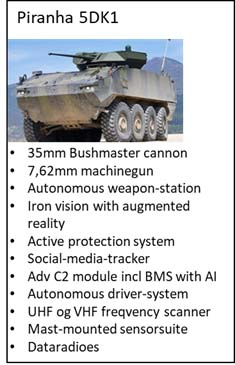
Sten sighs, sits up and flicks a pinecone off the map. “Yeah Steffen. That might be right, and that has been the plan all along. Break down the three brigades into battalion combat teams and then race off to fix the 63rd Donovian motor rifle division in western Otso supported by all available NATO cyber and fires, so the Yanks and Germans can outflank them through Donovia proper. I’ll be very surprised if Viking Coy gets to the border unharmed though – after all we are the lead company in the lead battalion.” He replies looking irritated at Steffen. “Well at least we are not acting as the brigade diversion force as the brits are.” Steffen snorts and starts fiddling with his coms-systems power hub.
A few hours later – just after midnight - onboard 1-9 Victor – the big Piranha 5 APC that First lieutenant Lene occupies alongside her first and second squads.
“Schmidt! Take over command of 5-Alfa! I’ll launch Hugin to have a look at the town up ahead!” Lene says in the vehicle’s intercom to the armored vehicles only crewman. “Roger! Taking command of 5-Alfa!” He replies and toggles the command on the big screen in front of him. The big Lindorm combat robot’s status and sensor-feed pops up in a window on his screen. The Advanced Infantry Platoon is an experiment that the Danish Army had planned for a while, with all sixteen Lindorm vehicles along with the smaller unmanned ground robots and aerial drones on loan from the manufacturer for the experiment. Now since all of NATO – almost – has suddenly been drawn into a war with Donovia on the European continent, the army decided to deploy with the two Advanced Infantry Companies sporting all the promised advantages of robotics, sensoring and artificial intelligence. But the rest of the Danish brigade is still equipped with the legacy Leopard 2 A7 tanks, CV9535 DK3 Armored fighting vehicles and the newer Stryker-on-steroids - the Piranha 5 armored personnel carriers. And so, it is with all the other units from across Europe now advancing along with 1st U.S. Armored Division who are equipped with next generation combat vehicles, and to some degree, some of the other new gadgets that was promised back in 2018 when Multi-Domain Operations was born.
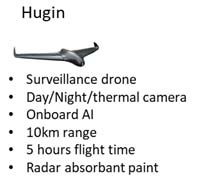
The 50-centimeter delta-winged drone launches from its launcher-box on the back of Lindorm 5-Alfa, climbs rapidly to an altitude of around 300 meters and proceeds towards the small town of Krachno, 4 kilometers down the road from Lenes advancing platoon. The drone is almost silent, and the shape makes it very hard to spot by the counter-UAS systems now spread widely among the Donovian army. Lene is following the drone’s video-downlink on one of the big 23inch screens in front of her. The drone flies its planned route making a search for enemy activity at the edge of the town. Anything with a body-heat of around 36,5 degrees Celsius or with an electronic-signature different from a pacemaker is picked up by the advanced onboard sensors, analyzed and sent back to the network by the artificial intelligence on the drone.
Two red diamond icons light up on the battle management map just after the second pass of a cluster of residential one-family houses in the outskirts of town.
“Viking-6 this is Viking-1! Contact! Enemy spotted in Krachno. Out!” Lene’s calm voice in the company radio totally hides her nervousness. This is the first time Danish soldiers has been in combat against a pear enemy since 1864, and the first time ever she faces combat. She has already confirmed the initial report on the screen. Now everybody on the Danish battle management system, and therefore the entire coalition can see the enemy icons on their electronic maps.
200-meters away Sergeant first class Michael Sørensen zooms his map in on Krachno in order to see if any of the coalition F35s can provide any more intel on the enemy in the platoon’s path. As the Platoon sergeant his Piranha 5 is set up the same as Lene’s, so the platoon can split-up in two sections each with a Lindorm combat-robot with its cargo and a Piranha 5 with two infantry squad of four soldiers.
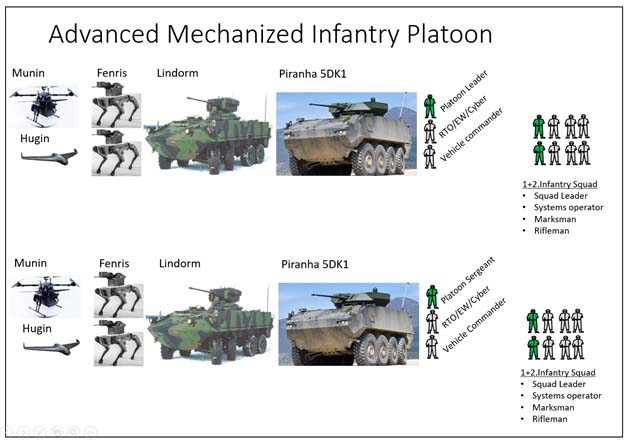
Two Dutch F35s on station over western Polovia conducting sensor-scanning for the 1st UK Strike Brigade, each releases an anti-armor weapon ordered by the Danish brigade Fire-Coordination-AI. The two long-range hyper-sonic missiles accelerate to mark 25 in a few seconds and continues towards the two four-wheeled armored-scout-vehicles from the Donovian 63d Motor rifle divisions recce Squadron hiding in Krachno.
Sten, Lene and Michael, and every other officer, NCO and soldier in the brigade with access to a screen – and that is almost everyone - sees the two explosions on the drone feed, and all to a man feels his heart sink when the smoke clears and sees the infantry mounting the two unharmed vehicles and calmly drive away into town, out of sight of the drone.
“9 this is 8! Their active protection system denied both missiles, they know we are coming, and we just lost contact!” Michael reports matter of factly on the platoon’s radio.
About half an hour later – at 0126 hours.
The platoon is now advancing in a deep V formation with the two Lindorm – 5-Alfa and 5-Bravo - in front and to the sides. 500 meters in front of them, a Munin quadcopter provides early warning along the axis of advance. The edge of Krachno appear two kilometers away on the sensor-feed from 5-Bravo’s Munin.
Lene halts the platoon and raises the masts on the two Piranhas. The autonomous weapon-stations on all four vehicles automatically coordinate their fields of fire and starts auto-scanning for threats. After having scanned the edge of town with the powerful sensors on the masts, Lene is about to order the platoon forward again when she spot the ditch. It’s not on the map and for some reason the mapping software has not picked up the presence of a four-meter-wide ditch between two fields. Captain Jensens command-element and the maneuver-support platoon with the two gun-mounted Lindorm – the King-Lindorm are about two kilometers behind. She knows that she needs to act quickly in order to keep up the momentum.
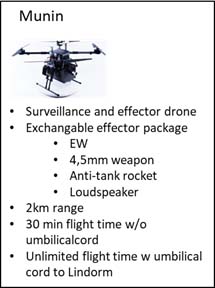
“Viking-6 this is Viking-1! There is a ditch up here! I need Echo-43 to get across. I’ll secure the crossing myself. Over!” she reports in the company radio.
“This is Viking-6. Roger! Echo is enroute. Out!” Jensen answers calmly.
“All stations this is 9! We are going to lay a bridge to get over the ditch in front of us. Our mission is to secure the crossing site! 5-Alfa and Bravo will secure the flanks about 500-meters out. 8 and 9-Victor will proceed as close to the ditch as possible. Then 1, 2, 3, 4 and 8 will dismount, cross the ditch and secure a bridgehead on the other side. There is still no line-of-sight to the town, so I don’t expect an opposed crossing. out!” Lene commands on the platoon net.
The two big wheeled APC’s starts plowing through the muddy field toward the drainage ditch. About one hundred meters from the ditch they stop and the infantry dismount. Michael dismounts along with his signaler and platoon medic. The four small squads advance on line towards the water-obstacle in a low run. None of them have been outside the vehicles for most of the day, so their muscles are stiff and cold. Half of the soldiers has just been woken from their sleep. Michael follows just behind third squad, commanded by sergeant Benny Johansen. Benny makes a quick hand-signal and the three other soldiers in the squad stops their jog and takes a knee, each watching his arc of fire. Benny toggles the FLIR-camera on his helmet off and raises the helmet visor. He has still not gotten used to new full-face combat-helmet’s confinement. Being used to hear the sounds of the night with his own ears, feel the cold night breeze on his cheeks and smell the damp soil, the artificial sound enhancement and all the helmet’s visual sensors just feels overwhelming. Benny toggles the button for the platoon net with his tongue. “9 this is 3! I’m by the ditch. Banks are steep. Ground not too soggy. Gab about four meters wide. No need for bank improvements before they throw the bridge! Crossing now!” He whispers with a hoarse voice. After another hand-signal the four soldiers starts down the ditch’s steep bank. Benny knows what awaits him and he hates it – he hates being cold and wet, just as any infantry soldier always have hated it through the times. He proceeds into the water, hoping to hit a solid sandy bottom quickly. But the boot just keeps sinking deeper into the icy water. He hears private Poul Hansen next to him gasp as the water reaches the systems operator’s crotch. In no time all four squads are across and in position in a hedge-line about one hundred meters from the ditch. The platoon is spread out and in position to engage any target in the fields in front of them. As usual the soldiers are carrying their M/26 rifles – a newer variant of the old AR-15 rifle type, the army has had for years. The rifles are in 6,8 millimeter – the new NATO standard – and equipped with electronic sights with target hand-over software and augmented reality connected to the helmet’s battle management system. The squad’s marksmen are carrying the 300 WIN-MAG M/24 rifles with the same scopes as the rest. The Squad rifleman also carries two 66-millimeter anti-tank-rockets with nano-explosives, for the unlikely event that a light armored enemy vehicle should pop-up close by.
There is maybe 300 meters to the next hedge and no signs of life anywhere.
Michael turns and looks as the big bridge-laying tank that comes rumbling from somewhere in the dark. He sees it in the helmets enhanced vision. The fused night vision, thermal and augmented reality gives him near total situational awareness. The new helmets were supposed to be part of the new infantry 2025 suite that was to roll out years ago. But the development of the promised powered armor suits or exoskeletons kept being delayed until the price of one suit got so high that only the most special of spec-ops units were getting any – and Michaels infantry platoon is not one of those. So, Michael is wearing the old worn body-armor with pouches, on top of his Nordic combat uniform – the same equipment that has followed Danish soldiers since 2012 when it was bought during the Afghanistan deployments.
The huge Leopard 2 tank quickly lays the bridge on the gab and then thunders of to its hiding place somewhere in the rear. Michael sees second platoon coming towards the bridge as the tank disappears. All is still quiet – except for all the diesel driven armored vehicles.
Michael settles in on the cold wet ground. The squads are only half strengths since the other half of the squads – the unmanned Fenris combat-robots – are still in the back of the Lindorm-robots, on the flanks of the bridge.
Half an hour passes, and the company’s supply trucks are yet to pass. The two other Advanced Infantry Platoons equipped like Lene and Michael’s are over and have expanded the bridgehead. Lindorm 5-Alfa and 5-Bravo are also over, and the platoon’s two Piranhas are on their way to pick up the dismounts when suddenly a distant whine of electric motors catch Michael’s enhanced hearing.
Scanning the horizon first with his helmet’s sensors and then with his advanced binocular, nothing appears out of the ordinary. No thermal signatures of the dreaded Donovian electric tanks or augmented reality icons reporting other enemy assets in the area, just a high pitch whine growing higher from the east.
“Dude! What is that noise?” Private first class Svend Olsen askes to no one in particular a few meters away from Michael. “I don’t know man. Sounds like a drone – actually a few drones…” Private Poul Hansen replies in the darkness.
Then suddenly all four 35-millimeter bushmaster cannons on second platoons’ vehicles start firing into the sky followed by the ones from third platoon. Red traces seem to be converging on unseen targets in the sky. Michael’s helmet-visor suddenly lights up with numerous indicators of inbound enemy drones. He sees first one, then another huge explosion as enemy drones kamikaze-dive into second platoon’s Piranha 5s and Lindorm, turning the expensive vehicles to burning hulks.
“Quick! Get your netting up now!” Michael shouts and rips his light multi-spectral camouflage-netting out from a cargo-pouch on his body-armor. There is frantic movement along the line of soldiers as everyone tries to hide himself from the enemy aircraft coming their way. Suddenly the hissing sound of incoming artillery-fire mixes in with the chaotic sounds of drones exploding and cannon fire. 152milimeter artillery rounds impact around the bridge-site with enormous booms, sending hot shrapnel and dirt flying in all directions. Michael and the platoon, all scared senseless by the sudden violence around them and their inability to do anything about it, tries to make themselves the smallest targets possible. It stops just as quickly as it started. Michael pears out from under the netting to a scene of chaos. About 300 meters away the two burning vehicles from second platoon lights up the dark sky. In third platoons position another vehicle is also burning. Michael can’t make out whether it’s a manned Piranha or a Lindorm-robot that has been hit. Behind him the remains of the bridge is broken in two and halfway hidden in the ditch. On the other side of the ditch one of the company’s supply trucks lay overturned. Michael can spot soldiers rushing to the truck to render aid to the wounded crew. Just 25 meters behind him the two Piranha 5’s of his own platoon is standing unharmed in the middle of the upturned field. As his senses slowly return to normal, he notices a voice in his ears… “8 this is 9! Mount up quickly!” Michael fumbles with the tongue activated buttons in the helmet but finds the platoon radio-key and acknowledges Lene’s command. “First platoon! Mount up quickly!” He shouts using the helmets external speakers, totally forgetting that everyone on the ground has heard the same radio message he just heard. The wet, cold and shaken soldiers get up, and run to their APCs.
Captain Sten Jensen scans the company’s status on the screen in front of him. The automated logistics and diagnostics-system links into the battle management system, giving the commander a real-time updated situational picture of the company’s logistical status. Jensen scratches his big red beard with his gloved hand and then keys the company radio on his crew-man’s helmet.
“Viking-5 this is Viking-6! Salvage and recover what you can and redistribute the soldiers on any vehicle that has space for them. We need to keep moving!”
“This is Viking-5. Roger! We have inbound medevac drones coming for the wounded. I need 15 minutes to get the remaining trucks over the ditch. The bridge was hit, so we are laying a new one. I recommend that you keep Viking-1 as your point platoon, since she has taken no casualties and are good to go!” the company XO replies.
“Viking-6. Roger 5! Viking-1! Advance as planned as soon as you are ready!” Jensen says and zooms the digital map in on to the town ahead of the company.
Lene’s four vehicles immediately start moving forward. The platoon advances slowly across the soggy fields. Being a few kilometers across the Otso border they expect to come across the front units of the 63th motor-rifle division at any time. Despite the high number of coalition air and ground sensors and space-based platforms, there is no clear picture of the enemy dispositions yet.
The last vehicles have not left the crossing-site yet. The US supplied medevac-drones have still not picked up all the wounded, so the company XO keeps a small element of soldiers near the crossing site.
As Krachno comes into view of the vehicles’ weapon-stations, Lene fears that it is occupied by more than just the Donovian recon-element they engaged earlier. Due to the river there is no way to bypass the buildup area normally inhabited by 6000 Otsovians.
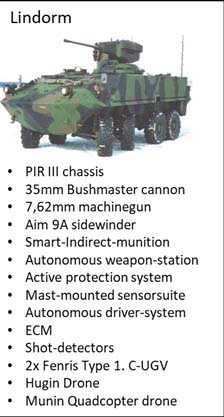
Lindorm 5-Alfa stops and starts scanning the edge of town with its autonomous weapon-station. The highway is leading straight into town and across the only bridge spanning the wide and fast flowing Otso-River dividing the town into two. The two Lindorm-robots built on the chassis of the old Danish Piranha III APC’s, a vehicle similar to the mothballed US Stryker vehicles, are moving cautiously forward on an automated overwatch and movement setting. 5-Alfa provides overwatch while 5-Bravo moves forward to the next position inside the village. The platoon’s two manned Piranha 5 vehicles are in position further back providing overwatch with their weapon-stations and mast-mounted sensors. 5-Bravo moves slowly forward along a hedgerow parallel to the highway. Its autonomous weapon-station focused on the houses just inside the edge of town along the highway. Lene has a Hugin drone providing topcover above the critical entry point into town. The robots’ EW-sensors are picking up a slightly increased use of the local 5G-net. Probably due to the two explosions earlier. Despite this the streets are empty, and light can only be seen in a few windows. Lene hopes that the population will stay in bed and not write about the Danish soldiers on the social media and thus tip off the enemy.
5-Bravo reaches its position in a front yard overlooking the road going into the town. As soon as it stops, Lene orders the two Fenris robots out to provide flank and advanced guard security. 5-Bravos ramp drops and the two machinegun armed four-legged combat-robots jumps out. Fenris-3 – normally the other half of third squad – takes up position to secure 5-Bravos right flank. Fenris-4 – normally part of fourth squad – runs about 50 meters ahead on the road and take up position behind a turned-over garbage bin.
Lene is orchestrating the whole thing from the back of her Piranha just 500-meters away. The robots, although highly evolved are still not able to conduct fully autonomous maneuvers, which limit the robots’ ability to conduct coordinated maneuvers. Lene is doing most of the thinking, ordering each robot into position, and then letting the robot find its way to that position on its own. While Lene is commanding the advanced element of robots Michael is in command of the two Piranhas with the platoon’s squads. His radio operator is monitoring the social media tracker meant to give early warning of civilian unrest or enemy special forces presence in the area.
Lene orders 5-Alfa forward. The eight wheeled ex-APC fires up and proceeds to a position on the corner opposite 5-Bravo. When in position, Lene also orders its cargo of Fenris robots in position on the flank and in advance of the Lindorm-robot.
“Viking-6 this is Viking-1! Proceeding into Krachno town now. Out!” Lene reports into her crew-man’s helmet, before ordering the six ground-robots to advance into town. Fenris-1 and 4 moves forward in bounds 50 meters in front of 5-Alfa and Bravo. The two Fenris robots is alternatingly jamming any radio-signal in the area and sending out high impulse signals intended to command-detonate any radio-initiated mine in the area. 5-Alfa and Bravo are proceeding slowly behind them, scanning all windows, doors and ally-ways for signs of a Donovian ambush. The houses along the road are old one-family houses and three-story concrete apartment buildings. The road is dimly lit by a street lamp every 50 meters. Most windows are dark. In the back-ally’s Fenris-2 and 3 are paralleling the Lindorms, providing early warning of any enemy about to man ambush-positions from adjacent buildings.
Finally, as the two Lindorm are approximately hundred meters into town Michael haves the two Piranhas follow the lead element.
“Contact! Contact! Wait out!” Lene suddenly screams on the company radio. The active protection systems on both 5-Alfa and 5-Bravo has just shot down two anti-tank missiles fired from across the Otso-river. Lene is simultaneously talking into the radio and approving the robot’s queries for permission to return fire as quickly as they pop up on her screen. It appears that there are numerable targets on the other side of the river. A few seconds later every vehicle in the platoon is engaged by rocket-propelled-grenade and small arms fire from the rooftops surrounding the platoon. The number of targets the weapon-stations on both Lindorm and Piranhas and Fenris’ query to engage multiplies by the second. Both Lene and Michael is frantically permitting the autonomous weapons to return fire.
“8! This is 9! There are too many targets! We are getting shot up her! I want you to dismount and clear the buildings along the road to give us some standoff. I’ll fight the robots and engage the armor on the other side of the river!”
“This is 8! Roger! I think you have to disregard all that man in the loop crap and just let the robots fight. I’m dismounting now. Out!…”
“1 and 2. Dismount and clear building 44 and 46 next to 9-Victor. I need Fenris-2 as flank protection, so you can call in Fenris-1! 3 and 4 you’ve got building 47 and 49. Take Fenris-3. I’ll be with 3 or 4. Dismount! Out!” Michael calmly commands in the platoon radio net. Then he rips of his crew-man’s helmet and fits his Advanced Infantry Helmet and jumps out behind third squad who are already making entry into the old three-story red-brick apartment building next to their Piranha APC.
Lene swears to herself and comes to the same conclusion as Michael. Without hesitation she pushes the button on the screen that the battalion commander told her never to use.
“Approve all targets – robots on full autonomous engagement mode”.
The robots and autonomous weapon-stations suddenly springs to live with an enormous roar. Four 35-millimeter cannons engage enemy fighters and armored vehicles all around the platoon. The Fenris-robot’s machineguns destroy enemy fighters while they are moving towards the building overlooking the platoon. The sounds overwhelm Lene as the Piranha’s ramp goes down and the two squads in the back of her vehicle dismount. She flicks on the iron-vision-visor on her crew-man’s helmet to better get a feel of the fight. She sees and hears the cannons engage targets in buildings just next to the vehicles, the incoming rockets exploding without hitting the vehicles and the dismounted platoon sprinting and gaining access to the buildings next to the Piranhas. She starts to toggle concentrations of enemy vehicles across the river and calling in fire on them.
The company maneuver-support platoon, just about to enter the town, stops for a minute as the call for fire is processed by the battalion Fire-Support-Coordination-AI, and the Smart-Indirect-Munitions launchers in the back of King-Lindorm call sign “King- Christian” is activated. Seven munitions are launched by powerful rocket motors projecting the part anti-tank munition and part loiter munition to an altitude of 500 meters. The seven munitions shoot across the short 2-kilometer gab until they acquire their designated targets with their own sensors. The collective AI in the munitions coordinate and select the most dangerous targets and all at the same time dive onto their targets. During their descend they emit jamming signals to confuse the enemy active protection systems. Five munitions reach their targets while two gets shot down by Donovian counter-UAS lasers on their front vehicles.
Lene keeps designating targets and soon both the maneuver-support platoon King-Lindorms are black on S-I- Munitions.
Sergeant Benny with third squad have already cleared the first story of building 47 and is making ready to take the third floor. Fourth squad is in the process of clearing the second floor.
“3 this is 4! We are 50% on second floor. I hear firing on third floor. I suggest that you proceed up there now to stop them firing on the rest of the platoon outside!”
“This is 3! Roger! I agree. We are on our way.” Benny replies with a cool voice.
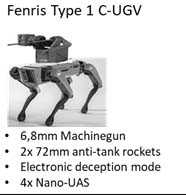
Seven seconds later third squad is stacked up by the wall on second floor. Benny gives his systems-operator, Private Poul Hansen a quick nod. Hansen sends Fenris-3 up the stairs to search and destroy any armed humans on the third floor. The gray wolf-like robot with the 7.62-millimeter M/60 machinegun on the back quickly jumps up the stairs in four huge jumps. The robot’s enhanced sensors quickly sense where the enemy soldiers are. Slowly and silently it proceeds to the closed door into the apartment it has designated as the enemy position. The fine-tuned robotic claw mounted just in front of the machinegun carefully turns the door knob and pushes the door. The door is locked and is not moving. The robot takes a step back and shoots open the lock with the machinegun, then it crashes through the floor, tearing it apart in the process. In the hallway an old lady slumps down on the chair she was bound to, clearly having been hit by the machinegun rounds. The robot continues into the living-room where it engages three armed Donovian soldiers. Killing them all with three quick bursts. Before it can turn to clear the rest of the apartment a grenade explodes next to it destroying it on the spot.
“Damn! Fenris is down!” Poul says on the squad channel. “Go! Go! Go!” Benny replies from his place as number three man in the four-man stack, almost pushing the two soldiers in front of his up the stairs. They quickly reach the third floor and the destroyed door. Just as the front soldier Private first class Lisa Jensen turns to enter the apartment a confused Donovian soldier exits the doorway. The two soldiers end up in a life and death hand to hand fight, while the rest of the squad pushes by and into the apartment. Benny hardly notices the two soldiers fighting as he enters the apartment’s hallway. The squad clears the apartment room for room, ending up in the shot-up living room. Parts of Fenris-3, smashed Ikea furniture, ceiling plates and old French art posters are scattered all over. By the two windows three dead Donovian soldiers lie where they were killed.
Lene finally feels on top of things. She is following the squad’s battles on their helmet-camera feeds on the screen in front of her. At the same time, she has been calling in fire every time an enemy vehicle has be spotted by her sensors. The battalion cyber specialist has succeeded in hacking into some of the local CCTV cameras most people have set up in their homes giving her an improved situational awareness. The enemy force in the town seems to be retreating. Lene’s signaller has been monitoring the social-media-tracker to gain some kind of early warning of the Donovian next move, but the number of contradicting messages makes the effort futile. Lene leans back in self-satisfaction and stretches.
“Eeeh boss! Why are the robots not responding? Or our weapon-station?” Corporal Smith says looking perplexed at the non-responding screen in front of him. “Yeah… my screen just went dead too.” Private Jensen chimes in. “What?” Lene replies just as the combined fires from four 122-millimeter MLRS batteries impact in and around her platoon, totally destroying the vehicles and robots and leveling all the buildings in a 500-meter radius.
